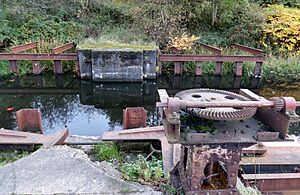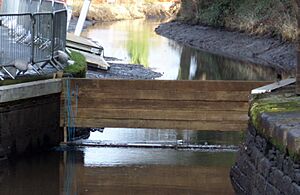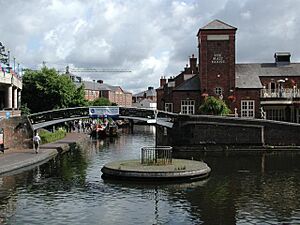Canal Safety Gates facts for kids
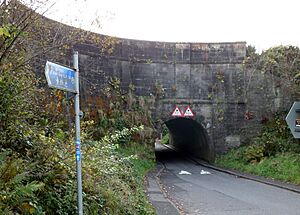
Canal safety gates are special structures built on canals. Their main job is to stop big floods. These floods could happen if a canal wall or a bridge carrying a canal (called an aqueduct) breaks. This might be due to natural events like storms, or during wars if enemies attack. These gates also help when canals need repairs. Simple wooden planks or large concrete and steel gates were used. They were often put in place quickly when air raid warnings were given.
Contents
Why Do Canals Need Safety Gates?
Canals hold a lot of water. If this water escapes, it can cause huge damage. Imagine a canal running high up on a hill, above houses or factories. If it breaks, a flood could be disastrous. To prevent this, engineers built special "canal safety gates" or "canal air raid protection gates."
These gates were made differently depending on the danger. Some were simple wooden planks called 'stop gates'. Others were massive structures of concrete and steel. Good examples are the gates on the Forth and Clyde Canal near Stockingfield Junction in Glasgow.
Sometimes, if a water link was no longer important for boats but still risky, it was closed off forever. This happened in Bristol at the start of World War II. They blocked off parts of the harbour to protect the city from floods.
Canals with Safety Gates Around the World
The Forth and Clyde Canal
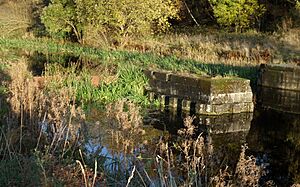
In 1942, two huge steel safety gates were built on the Forth and Clyde Canal in Scotland. They were placed near Stockingfield Junction. These gates were hand-cranked and could hold back the canal's water. This was important to stop serious flooding in Glasgow if the nearby Stockingfield Aqueduct was bombed. The next lock that could control water was about 27 kilometres away.
More safety gates were also built during World War II on the Glasgow Branch of the canal. These were at Firhill Road Narrows and Craighall Road Narrows. They protected the city from possible damage to two other aqueducts. The Stockingfield gates are still mostly there. At Firhill Road, mainly the concrete parts remain.
The Union Canal
The Union Canal is about 52 kilometres long. It was built as a 'contour canal', meaning it follows the natural shape of the land. This meant it didn't need locks to change water levels. However, this also meant it couldn't easily stop water loss if there was a break.
To keep people safe, engineers added gates between 1818 and 1822. These were single wooden gates at 19 different spots. They were used for safety and for canal repairs. Scottish Canals has even made two new wooden gates like the originals for Linlithgow.
The Gloucester and Sharpness Canal
The Gloucester and Sharpness Canal is about 27 kilometres long and up to 5 metres deep. If this canal broke, millions of litres of water would flood the area. So, many safety gates are placed along it. This canal also lacks locks, making the gates even more important. In an emergency, these gates close automatically. This helps control any flood risk, protecting Gloucester and nearby villages.
The Grand Union and Regent's Canal
The Grand Union Canal runs from London to Birmingham. It is about 220 kilometres long and has 166 locks. Safety gates, also called Air Raid Protection (ARP) gates, were installed at about 16 places. They were designed to close automatically if the canals were damaged during World War II air raids by the Luftwaffe. Many bombs fell near the canals in London during the war. However, no major flooding happened from canal damage.
The Air Raid Precautions (ARP) Department was set up in 1935. Its job was to make sure local groups helped the government prepare for air raids. Canals built on high ground, especially in busy areas like London, were seen as easy targets for bombs or sabotage. Flooding could endanger lives, stop transport, and harm factories.
In 1938, stop planks and safety gates were put in the Regent's Canal and the Grand Union Canal in the London area. Grooves for stop planks were cut at each end of aqueducts. The safety gates were built so they didn't block canal boats too much.
The Roundabout island at Old Turn Junction was added during World War II. It helped to install safety gates. These gates protected the railway tunnel of the Stour Valley Line that runs underneath. The canal was too wide at this spot. The island made it narrow enough for the gates to be put in when needed.
Dortmund–Ems Canal
The Dortmund–Ems Canal in Germany was a main target for bombing by the RAF in World War II. It also had safety gates to reduce flooding.
The Danube–Tisa–Danube Canal
The Danube–Tisa–Danube Canal system in Serbia is very large. It has 24 gates, 16 locks, and five safety gates.
A Small Piece of History
In March 1883, a group of people tried to damage the Possil Road Aqueduct. This aqueduct is on the Glasgow Branch of the Forth and Clyde Canal.


